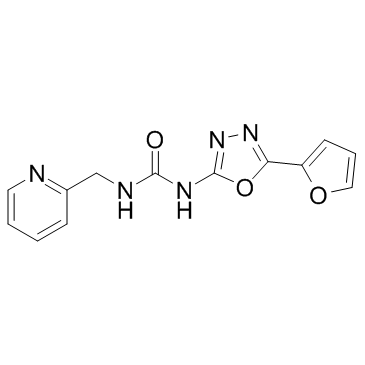| Description |
NK-252 is a potential Nrf2 activator, which exhibits a great Nrf2-activating potential.
|
| Related Catalog |
|
| Target |
Nrf2[1]
|
| In Vitro |
The luciferase activity in Huh-7.5 cells treated with Oltipraz (OPZ) or NK-252 shows activation of the NAD(P)H quinone oxidoreductase 1 (NQO1)-ARE in a dose-dependent manner. NK-252 displays this effect with higher potency than OPZ based on the fact that the EC2 value (concentration for a 2-fold induction above background), calculated with linear extrapolation from the values above and below the induction threshold, is 20.8 μM for OPZ and 1.36 μM for NK-252. NK-252 has potential as an Nrf2 activator in hepatic cells. Prototypical Nrf2 activators that include OPZ have been reported to protect microglial cells from H2O2-induced cytotoxicity. The protective effects of OPZ and NK-252 are examined against H2O2-induced cytotoxicity using Huh-7 cells to evaluate their antioxidant properties. The cells treated with OPZ or NK-252 show increased resistance to H2O2-induced cytotoxicity compared with control cells[1].
|
| In Vivo |
Rats on a choline-deficient L-amino acid–defined (CDAA) diet given OPZ or NK-252 display decreased fibrosis scores compared with CDAA control rats, with median scores of 3, corresponding to bridging fibrosis. CDAA control rats display approximately 20-fold augmentation of the liver fibrosis area compared with rats fed a normal control diet (naive) (14.7 and 0.72%, respectively).This augmentation is also drastically reduced by administration of OPZ or NK-252 (5.80% for OPZ, 6.20% for NK-252_low, and 4.97% for NK-252_high). The effects of NK-252 on both fibrosis score and fibrosis area are dose-dependent[1]. NK-252 alone has no antitumour effect in P388/S- and P388/VCR-mice. The combination therapy of Etoposide with NK-252 administered p.o. significantly increases the life-span of mice inoculated i.p. with P388/S compared with the corresponding therapeutic effects with Etoposide alone. The combination therapy with Etoposide and NK-252 significantly increases the life-span of mice inoculated i.p. with P388/VCR compared with the corresponding survival time with Etoposide alone[2].
|
| Cell Assay |
The Huh-7.5 cells, a subline derived from Huh-7 cells, are transfected with ARE/pGL4.32 by lipofectamine LTX. The stable clonal transfectant is isolated by selection in hygromycin B (0.1 mg/mL). Cells derived from stable clones are transfected with control or Nrf2 small interfering RNA by lipofectamine RNAiMAX (30 hours), then treated with OPZ, NK-252 (0.1-30 μM, 16 hours) , or DMSO alone (control). The luciferase activity values are measured using the Steady-Glo Luciferase Assay System[1].
|
| Animal Admin |
Rats[1] Six-week-old male Fischer 344 rats are randomly divided into four compound administration groups and four control groups. Compound administration groups of rats fed a CDAA diet receive oral administration as follows: 1) OPZ from 1 week after feeding at a dose of 60 mg/kg once daily for 9 weeks (CDAA+OPZ group; N=8), 2) NK-252 from 1 week after feeding at a dose of 20 mg/kg once daily for 9 weeks (CDAA+NK-252_low group; N=8), 3) NK-252 from 1 week after feeding at a dose of 60 mg/kg once daily for 9 weeks (CDAA+NK-252_high group; N=8), or 4) NK-252 from 6 weeks after feeding at a dose of 60 mg/kg once daily for 4 weeks (CDAA+NK-252_delayed administration: DA group; N=7). Two control groups of rats are fed a CDAA diet for 6 or 10 weeks (pre-CDAA control or CDAA control group; N=9 each), and the other two control groups of rats are fed standard rodent chow (CRF-1) for 6 or 10 weeks (prenaive or naive; N=3 each). Laparotomy and blood sampling are performed under isoflurane anesthesia. After blood sampling, rats are euthanized by exsanguination under isoflurane anesthesia, and the livers are immediately extirpated.[2]Mice[2] Six- to 8-week-old male BALB/c x DBA/2 F1 (hereafter called CD2F1) mice weighing 22 to 26 g are used. Male CD2F1 mice are inoculated i.p. with 106 cells of P388/S and P388/VCR cell line on day 0. Each group consist of six mice. NK-250 and NK-252 (100, 300, and 1000 mg/kg) are given p.o. daily from day 1 to 5. Mean survival days and the range of survival days are analysed.
|
| References |
[1]. Shimozono R et al. Nrf2 activators attenuate the progression of nonalcoholic steatohepatitis-related fibrosis in a dietary rat model. Mol Pharmacol. 2013 Jul, 84(1):62-70. [2]. Kiue A, et al. Enhancement of antitumour activity of etoposide by dihydropyridines on drug-sensitive and drug-resistant leukaemia in mice. Br J Cancer. 1991 Aug;64(2):221-6.
|

